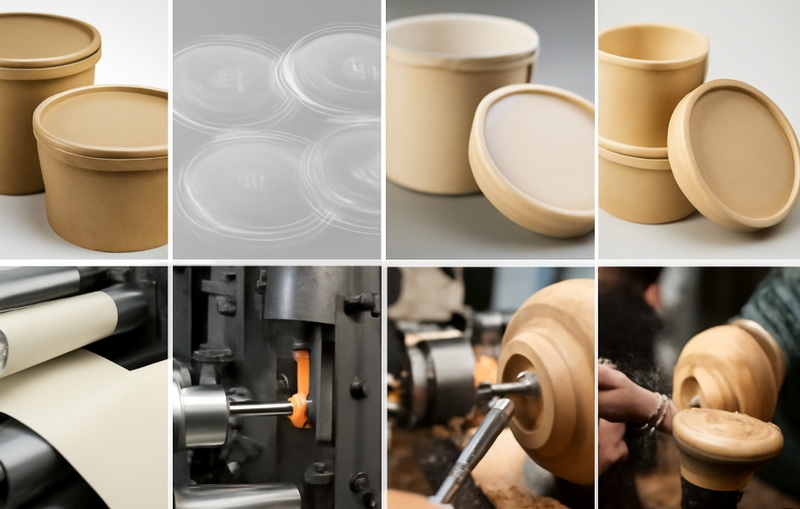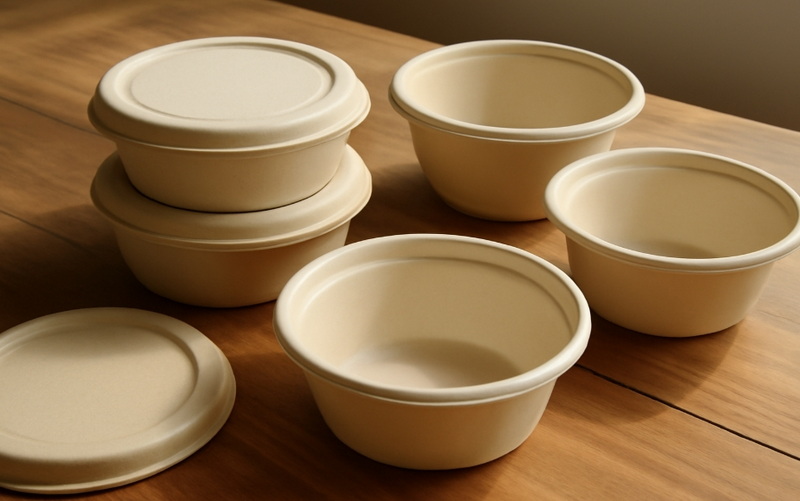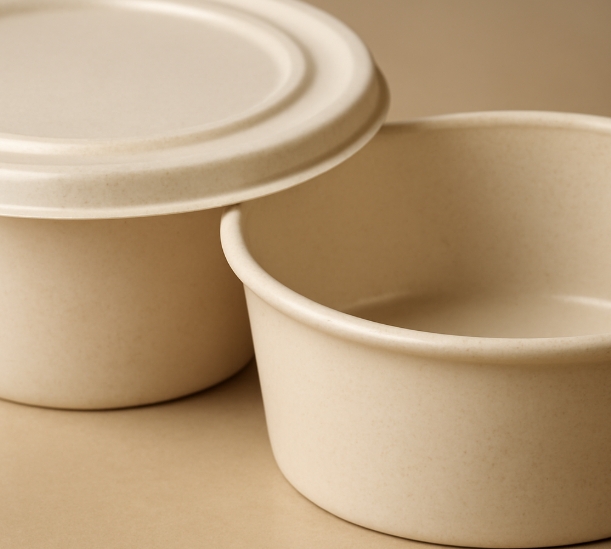
Content Menu
● Paper Materials in Bowl and Lid Manufacturing
>> Kraft Paper
>> Cupstock Paper (White Paper)
>> Bamboo Paper
>> Aluminum Foil Laminated Paper
>> Coatings and Barrier Films
● Plastic Materials in Bowl and Lid Manufacturing
>> Polypropylene (PP)
>> Polystyrene (PS)
>> Polyethylene Terephthalate (PET)
>> Biodegradable Plastics (PLA and CPLA)
>> Other Plastics
● Wood Materials in Bowl and Lid Manufacturing
>> Common Woods Used
>> Advantages of Wood Bowls and Lids
● Innovations and Trends in Materials for Bowl and Lid Manufacturers
>> Eco-Friendly and Compostable Products
>> Customization and Branding
>> Heat Resistance and Functional Performance
>> Matching Bowls and Lids
● Conclusion
● Frequently Asked Questions (FAQ)
>> 1. What types of paper are most commonly used by bowl and lid manufacturers?
>> 2. How do manufacturers make paper bowls waterproof?
>> 3. What plastic materials are used for bowl and lid production?
>> 4. Are wooden bowls with lids suitable for hot foods?
>> 5. How do manufacturers ensure lids fit bowls properly?
In the competitive landscape of food packaging, bowl and lid manufacturers play a crucial role in delivering products that meet the demands of functionality, safety, sustainability, and aesthetics. The choice of materials used by these manufacturers directly influences the quality, environmental impact, and consumer appeal of bowls and lids. This comprehensive article explores the primary materials employed by leading bowl and lid manufacturers, highlighting their characteristics, advantages, and applications. We will cover paper-based materials, plastics, metals, and wood, and discuss innovations in eco-friendly options that are shaping the industry.

Paper Materials in Bowl and Lid Manufacturing
Paper-based materials have become increasingly popular among bowl and lid manufacturers due to their sustainability, cost-effectiveness, and versatility. The main components of paper bowls are a paperboard base and a protective coating that prevents leakage and maintains structural integrity.
Kraft Paper
Kraft paper is one of the most widely used materials in paper bowl manufacturing. It is known for its strength, durability, and resistance to grease and moisture. Kraft paper is typically brown in color, providing an organic and eco-friendly appearance that appeals to environmentally conscious consumers. Virgin kraft paper, which uses minimal bleaching chemicals, offers enhanced sustainability. Kraft paper bowls are often coated with polyethylene (PE) or polylactic acid (PLA) films to create a waterproof and greaseproof barrier, making them suitable for hot and cold foods alike. These bowls can withstand high temperatures and are microwave-safe, making them practical for both food service and takeout applications.
Cupstock Paper (White Paper)
Cupstock paper, also known as white paper, is another common material used by bowl and lid manufacturers. It is crafted from renewable resources and provides a smooth surface ideal for high-quality printing, which is important for brand presentation. Cupstock paper bowls are typically laminated with one or two layers of polyethylene, depending on whether the bowl is intended for hot or cold food. This lamination enhances moisture and grease resistance. The white color of cupstock paper gives bowls a clean and modern look, making them popular in premium food packaging.
Bamboo Paper
Bamboo paper is an emerging material favored for its sustainability and natural antibacterial properties. Bamboo grows much faster than traditional wood pulp sources, making it a renewable resource. Bowls made from bamboo paper are lightweight yet strong, offering durability without compromising eco-friendliness. The antibacterial nature of bamboo helps extend the shelf life of food stored in these bowls. Bamboo paper bowls often feature a natural aesthetic that resonates with consumers seeking environmentally responsible products.
Aluminum Foil Laminated Paper
For applications requiring enhanced insulation and extended freshness, some bowl manufacturers use paper laminated with aluminum foil. This material provides an excellent barrier against moisture, grease, and odors. It is commonly used for disposable takeout containers and heat-and-serve bowls. The combination of paper and aluminum foil creates a premium product that balances strength with protective qualities.
Coatings and Barrier Films
To ensure food safety and prevent leaks, bowl and lid manufacturers apply various coatings to paper materials. The most common coatings include:
- Polyethylene (PE) Film: A plastic film that provides a moisture barrier.
- Polylactic Acid (PLA) Film: A biodegradable bio-plastic film derived from plant sugars, offering an eco-friendly alternative to traditional plastics.
- Water-Based Barrier Coatings: Plastic-free coatings that provide protection without compromising compostability.
These coatings are carefully selected to balance performance with environmental impact, supporting manufacturers' goals of sustainability.
Plastic Materials in Bowl and Lid Manufacturing
Plastic remains a significant material in the production of bowls and lids, especially for applications requiring durability, clarity, and heat resistance. Leading manufacturers choose plastics based on the intended use of the product, food safety requirements, and environmental considerations.
Polypropylene (PP)
Polypropylene is a favored plastic for disposable bowls and lids due to its strength, heat resistance, and chemical stability. PP bowls and lids can withstand hot foods and are often microwave-safe. PP is also resistant to moisture and grease, making it suitable for a wide range of food items, including soups, salads, and desserts. While PP is recyclable, its recycling rate varies by region, and manufacturers are increasingly exploring recycled PP to reduce environmental impact.
Polystyrene (PS)
Polystyrene is lightweight and inexpensive, commonly used for disposable bowls at casual events. However, PS is more fragile and less heat resistant than PP, making it less suitable for hot or heavy foods. Due to environmental concerns, its use is declining in favor of more sustainable plastics.
Polyethylene Terephthalate (PET)
PET is used primarily for clear lids due to its excellent transparency and strength. PET lids provide a good seal and allow consumers to see the contents of the bowl. However, PET is less heat resistant than PP and is generally used for cold food applications.
Biodegradable Plastics (PLA and CPLA)
Polylactic acid (PLA) and crystalline PLA (CPLA) are bioplastics derived from renewable plant sugars. These materials are compostable and increasingly used for lids and bowls in eco-friendly product lines. PLA lids are suitable for cold and room temperature foods but have a lower heat resistance compared to PP. Manufacturers often combine PLA coatings with paper bowls to create fully compostable products.
Other Plastics
Manufacturers also use specialty plastics such as acrylonitrile-styrene (AS), acrylonitrile butadiene styrene (ABS), polyoxymethylene (POM), thermoplastic elastomers (TPE), and polycarbonate (PC) for specific lid components like buttons, gears, or handles. These materials offer mechanical strength, chemical resistance, and ease of processing but are less common in the main bowl or lid body.

Wood Materials in Bowl and Lid Manufacturing
Wood bowls with lids represent a niche but growing segment in the market, prized for their natural beauty and artisanal appeal. Leading manufacturers and craftspeople use various hardwoods and specialty woods to create durable and attractive bowl and lid sets.
Common Woods Used
- Sycamore: Known for its fine grain and workability, often used for lids with decorative spalting (natural wood patterning).
- Magnolia: A light-colored wood favored for bowl bodies.
- Tamarind, Spalted Maple, White Palm: Used for bowls, lids, and knobs, offering unique aesthetics and durability.
Wood bowl and lid manufacturers typically use lathe turning techniques to shape the wood, followed by sanding and finishing with food-safe oils such as tung oil. These bowls are durable, reusable, and provide a premium alternative to disposable options.
Advantages of Wood Bowls and Lids
- Natural antibacterial properties depending on the wood species.
- Unique, handcrafted appearance.
- Biodegradable and renewable.
- Suitable for serving dry or room temperature foods; not typically used for hot or liquid foods due to absorption concerns.
Innovations and Trends in Materials for Bowl and Lid Manufacturers
Eco-Friendly and Compostable Products
There is a strong trend toward sustainability in the bowl and lid manufacturing industry. Manufacturers increasingly use biodegradable materials such as PLA-coated paper, bamboo fiber paper, and bagasse (sugarcane fiber) to reduce environmental impact. These materials are compostable and help reduce plastic waste.
Customization and Branding
Leading manufacturers offer extensive customization options, including custom printing on paper bowls and lids, various colors (kraft brown, white, bamboo natural), and tailored lid designs to ensure a tight fit and prevent leakage. High-quality printing on smooth cupstock paper enhances brand visibility.
Heat Resistance and Functional Performance
Manufacturers are improving the heat resistance of bowls and lids to accommodate hot foods and microwaving. For example, PP lids can withstand high temperatures, while PLA lids are better suited for cold or room temperature foods.
Matching Bowls and Lids
A key focus for manufacturers is ensuring that lids fit bowls perfectly to prevent spills during takeout and delivery. This involves precise design and multiple rounds of adjustment to optimize closure.
Conclusion
Leading bowl and lid manufacturers utilize a diverse range of materials tailored to meet the needs of different food service applications. Paper materials such as kraft, cupstock, and bamboo paper dominate the eco-friendly disposable bowl market, often combined with coatings like PE and PLA for moisture resistance. Plastics such as polypropylene and PET remain popular for their durability and heat resistance, especially for lids. Wood is favored for artisanal, reusable bowls and lids, offering natural beauty and sustainability. The industry continues to innovate with biodegradable materials and customization options, balancing functionality with environmental responsibility. Understanding these materials helps businesses and consumers make informed choices aligned with their values and practical requirements.

Frequently Asked Questions (FAQ)
1. What types of paper are most commonly used by bowl and lid manufacturers?
Bowl and lid manufacturers commonly use kraft paper, cupstock (white) paper, bamboo paper, and paper laminated with aluminum foil. Kraft paper is durable and eco-friendly, cupstock paper offers excellent printing surfaces, bamboo paper is sustainable and antibacterial, and aluminum foil laminated paper provides extra moisture and odor barriers.
2. How do manufacturers make paper bowls waterproof?
Manufacturers apply coatings such as polyethylene (PE) film, polylactic acid (PLA) film, or water-based barrier coatings to the paper surface. These coatings prevent liquids from leaking through the paper and protect the bowl from grease and moisture.
3. What plastic materials are used for bowl and lid production?
Common plastics include polypropylene (PP), polystyrene (PS), polyethylene terephthalate (PET), and biodegradable plastics like PLA and CPLA. PP is popular for its heat resistance and durability, PS for lightweight disposables, PET for clear lids, and PLA for compostable options.
4. Are wooden bowls with lids suitable for hot foods?
Wooden bowls with lids are generally better suited for dry or room temperature foods. Wood can absorb moisture and is not typically recommended for hot or liquid foods unless specially treated. They are prized for their aesthetic and reusable qualities rather than heat resistance.
5. How do manufacturers ensure lids fit bowls properly?
Manufacturers design lids and bowls with precise dimensions and conduct multiple rounds of adjustments and testing to ensure a tight fit. This prevents leakage and spillage, which is especially important for takeout and delivery applications.

















